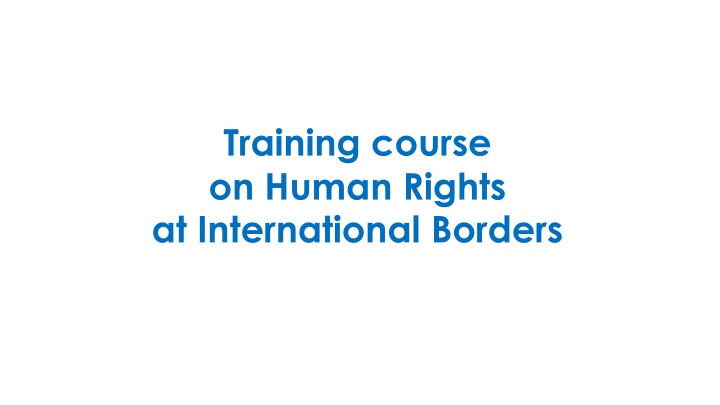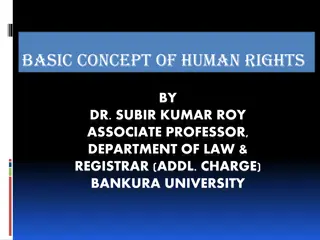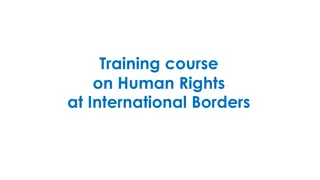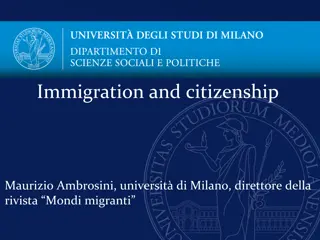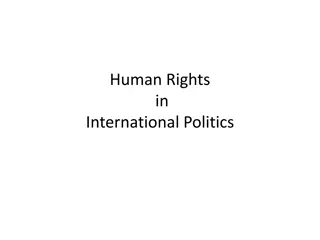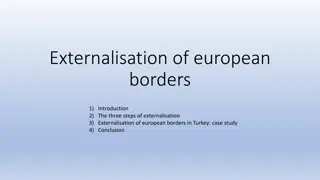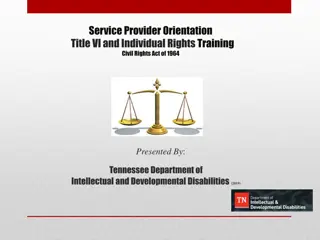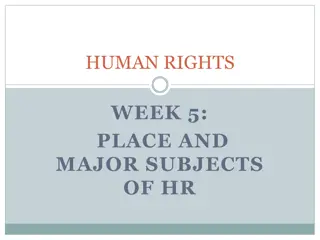Training Course on Human Rights at International Borders
This training course focuses on human rights at international borders, emphasizing the importance of a human rights-based approach to border security and management. Participants will learn about key concepts, rights of migrants, due process, gender-responsive approaches, and more. Through reflective exercises and discussions, learners will explore ways to implement their learning and uphold human rights at borders.
Download Presentation

Please find below an Image/Link to download the presentation.
The content on the website is provided AS IS for your information and personal use only. It may not be sold, licensed, or shared on other websites without obtaining consent from the author.If you encounter any issues during the download, it is possible that the publisher has removed the file from their server.
You are allowed to download the files provided on this website for personal or commercial use, subject to the condition that they are used lawfully. All files are the property of their respective owners.
The content on the website is provided AS IS for your information and personal use only. It may not be sold, licensed, or shared on other websites without obtaining consent from the author.
E N D
Presentation Transcript
Training course on Human Rights at International Borders
Session 7 Wrap-up of training course
Session 7 content 7.1 Key learning points/messages of the training course 7.2 Reflection: Putting learning into practice
Session 7 learning objectives After this session, learners will be able to: Describe the main points of a human rights-based approach to border security and management Gather ideas as to how they may be able to implement what they have learned
7.1 Key learning points/messages of the training course
Session 1: Introduction to human rights Human rights are inherent and inalienable: all people at international borders, including migrants, regardless of their status, are entitled to the same human rights. States (as duty-bearers) have specific obligations towards individuals (the rights-holders) under their jurisdiction. The right to due process applies in all border governance contexts to ensure that every individual is treated fairly and with respect for their human rights. The tests of lawfulness, necessity and proportionality are crucial in any consideration of limitation to the human rights of individuals at international borders.
Session 1 key messages (contd.) Human rights should be at the centre of all border governance measures: migrants must be protected against any form of discrimination and priority should be given to providing assistance and protection from harm. That means that human rights obligations take precedence over law enforcement and migration management objectives. A gender-responsive rights-based approach to border governance is necessary to account for different experiences, views and needs of both migrants and border authorities, taking into account gender, age and other factors. International human rights law and the rule of law are complementary and both must be respected as they are essential to successful efforts to effectively prevent and
Session 2: Migrants in vulnerable situations at international borders Some migrants need specific human rights protection because of the situations they left behind; the circumstances in which they travelled; the conditions they face on arrival; or because of personal characteristics such as age, gender identity, disability or health status. Although a migrant who is in or has experienced a vulnerable situation may fall outside the specific legal category of refugee , it is important to ensure that their specific human rights protection needs are met. An individual s need for human rights protection can change in the course of their journey or over time.
Session 3: Ensuring human rights in interception, rescue and immediate assistance Border officials play an essential role in protecting the lives and safety of all migrants, including those in vulnerable situations, in interception, rescue and immediate assistance. Planning for interception, rescue and immediate assistance is vital. Avoid dangerous interception methods. Any use of force by law enforcement should be exceptional and must meet the requirements of legality, necessity, proportionality, non-discrimination, precaution and accountability. The risk of harm must never outweigh the advantage of using force.
Session 4: Ensuring human rights-based screening and interviewing at international borders Human rights-based screening and interviewing should always be based on an individualised approach and assessment. Avoiding stereotyping and discriminatory approaches is essential for a human rights-based approach and for effective border security and counter-terrorism investigations. One of the objectives of screening and interviewing is to identifyindividuals who may be in vulnerable situations and facilitate referrals to the appropriate support services. The right to privacy should be protected throughout screening and interviewing, including with regard to the
Session 5: Avoiding detention and inadequate conditions of detention Irregular migration is not a crime; at most it may be considered an administrative offence. Immigration detention should be avoided; it should be an exceptional measure of last resort. Regarding children, immigration detention is never in the best interests of the child and is therefore prohibited. There are many human rights-based, non-custodial alternatives to immigration detention. Detention can create, increase or exacerbate situations of vulnerability for migrants. Respect for the dignity of detained migrants must be guaranteed.
Session 6: Human rights-based return Returns must always be based on an individual assessment of each case. No one shall be returned to a situation where they may be in danger of being subjected to torture, persecution or other serious human rights violations. States should ensure that returns are lawful and sustainable in order to avoid recurring cycles of insecure and irregular migration that carry human rights risks for migrants. All returns must follow due process and procedural safeguards. Voluntary return, free from any coercion, should always be promoted in preference to forced return in order to enable migrants to return to their countries with dignity.
7.2 Reflection: Putting learning into practice
What have you learned during the training course? First of all, think about what you have learned: New knowledge about human rights New perspective on gender, discrimination, vulnerability New information, concepts, analyses, ideas New understandings New ways of looking at migrants New ways of communicating
How can you put what you have learned into practice? 1. What learning points/messages can you incorporate into your work? 2. What areas of work will you approach differently after this course? 3. What learning points would you like to discuss further with colleagues/senior officials to secure their support in relation to making changes? 4. What areas do you want to learn more about in order to make changes? How can you do that? 5. What changes can you make immediately? What changes do you want to make by a certain time? It is good practice to set targets/time frames.
Training course on Human Rights at International Borders [PLACE, DATE] THANK YOU!
